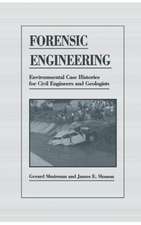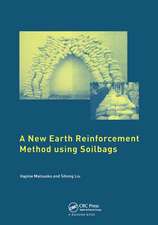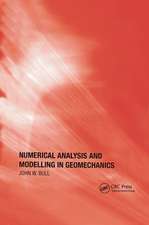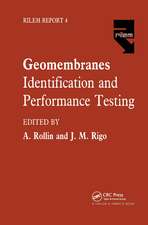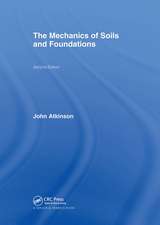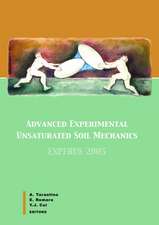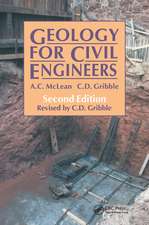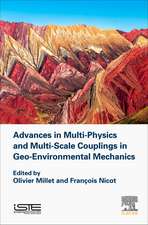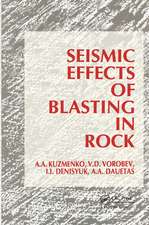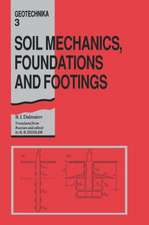Strength of Dilating Soil and Load-holding Capacity of Deep Foundations: Introduction to theory and practical applications
Autor D. Yu Sobolevskyen Limba Engleză Hardback – 1995
Preț: 1550.35 lei
Preț vechi: 1890.67 lei
-18% Nou
Puncte Express: 2326
Preț estimativ în valută:
296.67€ • 317.23$ • 247.35£
296.67€ • 317.23$ • 247.35£
Carte tipărită la comandă
Livrare economică 18 aprilie-02 mai
Preluare comenzi: 021 569.72.76
Specificații
ISBN-13: 9789054101642
ISBN-10: 9054101644
Pagini: 254
Dimensiuni: 178 x 254 x 16 mm
Greutate: 0.61 kg
Ediția:1
Editura: CRC Press
Colecția CRC Press
ISBN-10: 9054101644
Pagini: 254
Dimensiuni: 178 x 254 x 16 mm
Greutate: 0.61 kg
Ediția:1
Editura: CRC Press
Colecția CRC Press
Cuprins
Introduction -- Part 1: Strength of dilating non-cohesive soil -- 1 Dilatancy as a fundamental property of granular media -- 1.1 On the term ‘dilatancy’ -- 1.2 Interaction of grains in non-cohesive soils -- 1.3 Changes in soil density in the process of failure -- 1.4 Plastic and elastic deformations of non-cohesive soils -- 1.5 Dilatancy and the stress condition of soil -- 1.6 Examples of free and constrained dilatancy -- 1.7 Manifestation of dilatancy in soil strength tests -- 1.8 Conclusion -- 2 Models of elasto-plastic deformations of dilating non-cohesive soil -- 2.1 General propositions -- 2.2 Models of contact shear -- 2.3 ‘Soil-to-soil’ shear model -- 2.4 Model of internal bulge -- 2.5 Justification of the assumption regarding elastic reaction of the massif to dilatancy -- 2.6 Conclusion -- 3 Instruments and methods for soil testing in the conditions of constrained dilatancy -- 3.1 General propositions -- 3.2 Dilatometric Apparatus of Contact Shear (DACS) -- 3.3 Dilatometric Apparatus of Direct Shear (DADS) -- 3.4 Special testing method with the use of the serial shear apparatus BCB-25 -- 3.5 Dilatometric Apparatus of Contact Shear of reinforcing elements (DACS-A) -- 3.6 Dilatometric Triaxial Apparatus (DTA) -- 3.7 Conclusion -- 4 Contact shear in conditions of constrained dilatancy -- 4.1 General propositions -- 4.2 The influence of dilatancy constraint on resistance of soil to contact shear -- 4.3 Dilatant component of strength as a function of massif elasticity -- 4.4 Angle of contact friction as a function of massif elasticity -- 4.5 The influence of initial soil density and grain size -- 4.6 Influence of moisture content -- 4.7 Values of dilatant strains -- 4.8 Influence of grain strength -- 4.9 Critical density and critical normal pressure -- 4.10 Peak and residual strength of sands -- 4.11 On reasons for curvature of function xu = f(Gn ) -- 4.12 Cyclic shear in conditions of constrained dilatancy -- 5 Direct shear in conditions of constrained dilatancy -- 5.1 General propositions -- 5.2 Influence of constraint on dilatancy on resistance to shear -- 5.3 Dilatant component of strength and angle of internal friction as functions of massifs elasticity -- 5.4 Comparison and peculiarities of tests in dilatometric instruments of various designs -- 5.5 Conclusion -- 6 Internal bulge as a manifestation of conditions of constrained dilatancy -- 6.1 General propositions -- 6.2 Influence of dilatancy on stress-deformative condition of soil during triaxial compression -- 6.3 Adjustments for dilatancy in Coulomb-Mohr’s strength conditions -- 6.4 Angle of internal friction as a function of massif elasticity -- 6.5 Peculiarities of soil deformation with constrained dilatancy -- 6.6 Conclusion -- 7 Conditions of strength of dilating non-cohesive soil -- 7.1 General propositions -- 7.2 Ultimate resistance to shear -- 7.3 Ultimate state during triaxial compression -- 7.4 Conclusion -- Part 2. Deep foundations in dilating soil -- 8 Constrained dilatancy as a factor of load-holding capacity of deep foundations -- 8.1 General propositions -- 8.2 Bore piles of Type 1 -- 8.3 Bore piles of Type 2 and footings of Type 1 -- 8.4 Bore piles of Type 3 -- 8.5 Bore piles of Types 4, 5 and footings of Types 2, 3 -- 8.6 Injection piles and anchors -- 8.7 Piles constructed with soil displacement -- 8.8 Factors of stress-deformative condition at the contour of a bore pile -- 8.9 Conclusion: Reasons for the failures of theoretical calculation methods -- 9 Load-holding capacity of a single pile -- 9.1 Calculating scheme -- 9.2 Propositions regarding calculation of bore piles -- 9.3 Propositions for calculating bore piles with injected base and shaft -- 9.4 Propositions for calculating injection piles -- 9.5 Propositions for calculating piles manufactured with displacement of soil -- 9.6 Conclusion -- 10 Load-holding capacity of a deep footing -- 10.1 Calculating scheme -- 10.2 Load-holding capacity along the skin surface -- 10.3 Load-holding capacity at the lower end -- 10.4 Equation for calculating the total load-holding capacity -- 10.5 Conclusion -- 11 Load-holding capacity of an injection anchor -- 11.1 Calculating scheme -- 11.2 Contact resistance to shear along the root surface -- 11.3 Critical length of compressed root -- 11.4 Equation for calculating the load-holding capacity -- 11.5 Group effect of anchors -- 11.6 Conclusion -- 12 Sketches of several dilatancy manifestations -- 12.1 Reinforced earth as a composite material -- 12.2 Distortion and liquefaction of sands -- 12.3 Dilatant nature of contact filtration and negative friction along the pile shafts -- 12.4 Realization of the factor of dilatant strength during tunnelling -- 12.5 Dilatancy and seismic activity -- 12.6 Dilatancy in cracks of stone constructions -- 12.7 Reinforced concrete as a dilating composite material -- General conclusions -- Appendix 1 -- Appendix 2 -- References -- Subject -- index.
Notă biografică
Dmitry Yu. Sobolevsky was bom on 8 August 1959 in Minsk, Belarus. In 1198 U graduated from the Byelorussian State Polytechnical Academy (BSPA), Faculty of Civil Engineering. His Ph. D. thesis, which he defended in 1985, treated ground anchors an& in 1993 he delivered his D.Sc. thesis on dilatancy problems in soil mechanics at St. Petersburg Technical University. D. Yu. Sobolevsky worked as a lecturer in the field of geotechnics and researcher in soil mechanics of BSPA. He is known in Belarus and other cou^^s of the former USSR as a consultant and specializes in deep foundations, underground constructions, grouting and anchoring. In 1994 he became the Head of the Department for Geotechnics .and? Environmental Engineering of BSPA, the main geotechnical organization of Belarus.
Descriere
Introduces the theory and practical application of dilating soil and the load-holding capacity of deep foundations. Topics covered include dilatancy as a fundamental property of granular media, direct shear in conditions of constrained dilatancy, ...


